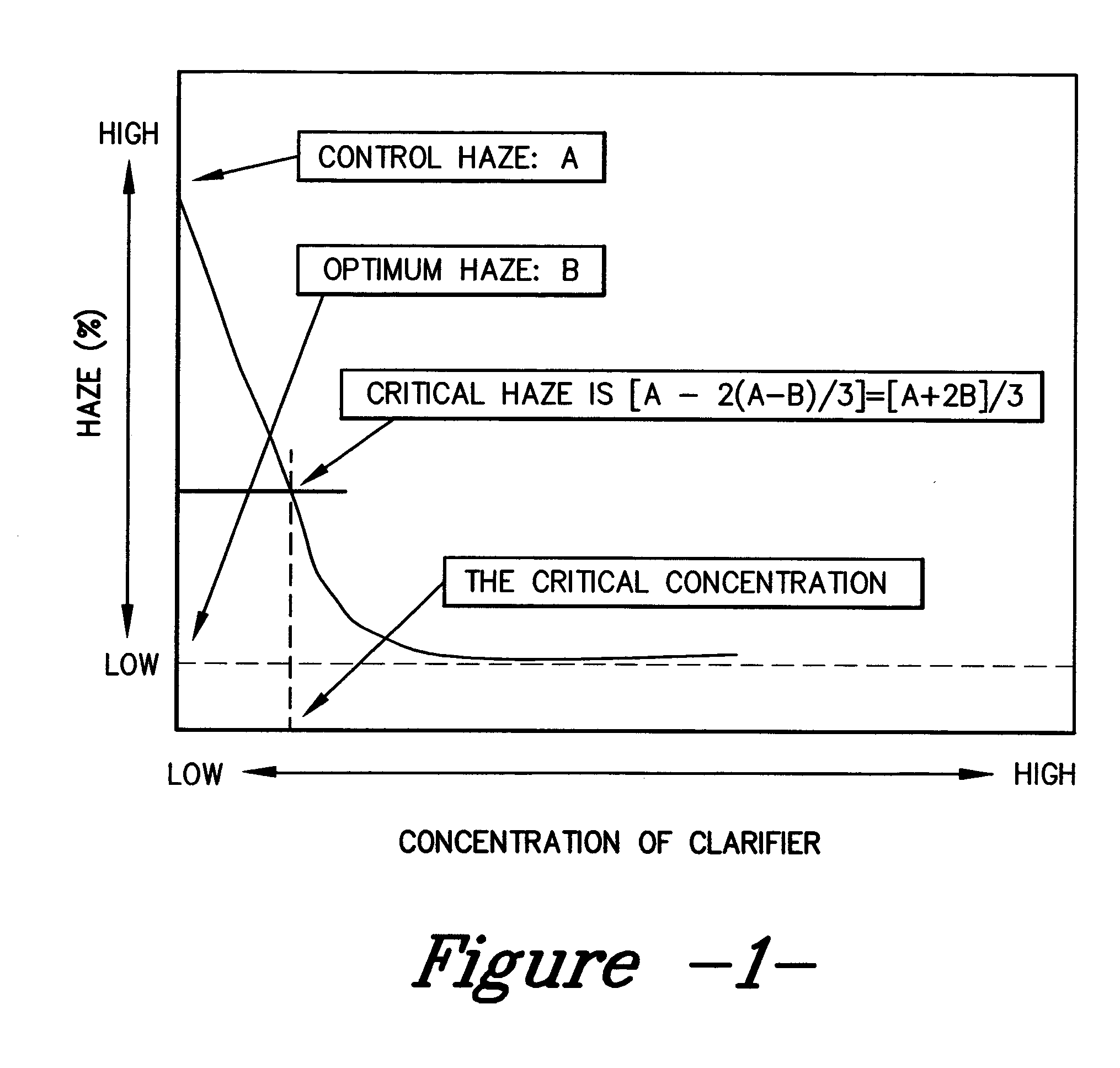Co-additive compositions and methods for applying co-additive compositions into nucleated polymer compounds
- Summary
- Abstract
- Description
- Claims
- Application Information
AI Technical Summary
Benefits of technology
Problems solved by technology
Method used
Image
Examples
example 1
PEG3400 as a Co-Additive for Millad 3988® in a RCP Resin
[0037] PEG 3400 is employed as a co-additive in this example. PEG 3400 is chemically known as poly(ethylene glycol), and 3400 refers to the average molecular weight of this particular grade. The general chemical structure of PEG is
where n is the repeating unit. The value of n determines the molecular weight of the polymer. Such structure is also termed PEO as poly(ethylene oxide) when molecular weight is high.
[0038] PEG 3400 was added to the formulation at 50 ppm along with a certain given loading of Millad 3988®. The haze performance of this formulation was then compared with Millad 3988 without co-additive at the same loading. Both formulations were processed under standard processing conditions. FIG. 3 shows the comparison between the two.
[0039] Millad 3988® at 50 ppm with PEG 3400 shows less haze than Millad 3988® alone at all loadings tested (500, 750, 1000 and 1250 ppm). At 500 ppm of Millad 3988®, haze reduction is...
example 2
Polycaprolactone Triol as a Co-Additive for Millad 3988® in a RCP Resin
[0042] Polycaprolactone triol (Mn=900) was used as a co-additive for Millad 3988® in this example to decrease its critical concentration. General chemical structure of polycaprolactone triol is as follows:
where m, n, p stand for the number of repeating units for each strand, and they could be same or different. The average molecular weight of the particular grade used is ca. 900 g / mol and is a waxy material at room temperature. 50 ppm of polycaprolactone triol was added to the formulation in liquid after being preheated at 60 degrees C. Both Millad 3988® formulations with and without co-additive were extruded at 230C using a single screw extruder and molded at 230 degrees C. in a random polypropylene copolymer, RCP SA849.
[0043]FIG. 4 shows the haze curve of Millad 3988® without and with polycaprolactone triol (Mn 900) as a co-additive. It dramatically improves the low level efficacy of haze performance for M...
example 3
Cleartint® Red as a Co-Additive for Millad 3988® in a HPP Resin
[0046] This example employs Cleartint® Red and its corresponding coupler as co-additives. Reference is made to FIG. 5.
[0047] Cleartint® Red is a polymeric colorant product produced and manufactured by Milliken & Company of Spartanburg, S.C., USA. 1000 ppm Cleartint® Red was added as masterbatch and Hobalt mixed and single screw compounded. The formulation was then molded at 230 degree C. In this case, a polypropylene homopolymer was used as the base resin. Haze curve of Millad 3988®, and Millad 3988® with 1000 ppm Cleartint® Red as co-additive is shown in FIG. 5. For Millad 3988® alone, control haze A=56.2, and the optimum haze=9.2, and the critical haze=[56.2+2*9.2] / 3=24.9. Critical concentration is, as shown in FIG. 5, 1273 ppm. In the case of Millad 3988® with 1000 ppm Cleartint® Red as co-additive, the critical concentration is reduced to 687 ppm. With the help of 1000 ppm Cleartint® Red, 687 ppm can achieve the cr...
PUM
| Property | Measurement | Unit |
|---|---|---|
| Fraction | aaaaa | aaaaa |
| Fraction | aaaaa | aaaaa |
| Fraction | aaaaa | aaaaa |
Abstract
Description
Claims
Application Information
 Login to View More
Login to View More - R&D
- Intellectual Property
- Life Sciences
- Materials
- Tech Scout
- Unparalleled Data Quality
- Higher Quality Content
- 60% Fewer Hallucinations
Browse by: Latest US Patents, China's latest patents, Technical Efficacy Thesaurus, Application Domain, Technology Topic, Popular Technical Reports.
© 2025 PatSnap. All rights reserved.Legal|Privacy policy|Modern Slavery Act Transparency Statement|Sitemap|About US| Contact US: help@patsnap.com



